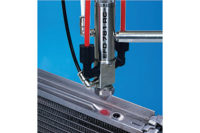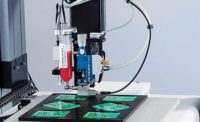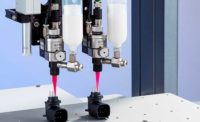Automotive manufacturers are using more adhesives, sealants, oils, and coatings than ever before. For example, today’s vehicles typically contain as much as 40 pounds of adhesive.
Whether it’s a handheld pneumatic benchtop dispenser or a diaphragm valve mounted to a robot, automotive assemblers will require some form of automated dispensing equipment to minimize waste, ensure quality and increase productivity.
Many of the high-performance materials needed to bond dissimilar materials and seal exposed parts are expensive, making waste reduction an important issue. In many applications, elimination of over-deposits can reduce material waste by 50 percent or more. Due to the high-volume production of many automotive assemblies, a reduction of even 10 percent can provide manufacturers with fast equipment payback and ongoing savings.
Look for systems designed to empty material reservoirs as completely as possible, minimizing waste during changeovers. Closed-system designs also reduce waste by minimizing premature curing of materials.
Quality is another reason to invest in automation. Applying adhesives, sealants and other materials with precision is critical, because many of these deposits seal components from environmental damage and general wear and tear. Precise deposit control also ensures optimal cure times and stronger bonds.
Automated dispensing systems provide consistent, high-quality output of fluids, cutting costs and reducing labor time for rejects and rework. The actual saved costs depend on the rework time or, more likely, the manufactured cost of the rejected part that will be discarded.
Automated dispensing systems provide repeatable and reliable deposit sizes—even with different operators. Controlled dispensing also keeps the assembly looking neat, prevents material contamination, and avoids messy workstations.
Finally, controlled, precision dispensing often increases output while maintaining—and even increasing—product quality. Due to faster and more consistent material dispensing, operators and assembly machines can typically produce more good parts per hour. Cleaner application means less time and cost for cleanup, and rejects and rework due to misapplied material are eliminated. Consistent deposit size leads to constant curing times and speeds part transfer to the next assembly step. This reduces bottlenecks and speeds overall production.
Dispensing Adhesives
Anaerobic adhesives are used on many auto parts, including suspension struts, bolts and fuel filters.
For higher volume applications, the 752V-SS diaphragm valve is recommended for dispensing anaerobics and other reactive fluids. This compact, lightweight valve is easily integrated into automated assembly processes. Its seal-less design incorporates an inert polymer diaphragm that isolates the actuator from the valve. Valve open time can be as short as 15 milliseconds. It has an adjustable open-close stroke of 0.13 to 0.64 millimeter, providing fast response times and positive shutoff.
For lower volume applications, the Ultimus operator-controlled dispenser is a good choice. This benchtop dispenser uses air pressure and microprocessor-based timers to produce accurate, consistent shots. It features simultaneous digital display of all dispenser settings and time adjustment as fine as 0.0001 second.
Anaerobic adhesives are also applied on internal engine bores and cap plugs. The 7860C radial spinner system is used to apply a coating to the internal walls. The system consists of a compact air-driven motor, a valve and controller. The valve dispenses a precisely metered amount of fluid onto a spinning disk attached to the motor. As fluid reaches the edge of the disk, it spins off, forming a neat band inside the part. The system can apply fluids inside cylindrical parts between 0.4 and 5 inches in diameter.
Automotive electronics are often potted and sealed with UV-cure adhesives. For applications requiring microdots, the 741MD-SS valve can produce deposits of UV-cure adhesive as small as 0.007 inch in diameter. It features an adjustable needle stroke, which allows the user to maintain exact deposit size. For filling, potting or sealing electrical components, the 741V needle valve is the best choice. The 741V-SS is made of passivated 303 stainless steel and features no dead fluid volume between shots.
Cyanoacrylate is often used on hoses, shock absorbers, sunroofs and mirror assemblies. Machined from an inert ultra-high-molecular-weight polymer, the 752V-UHSS valve is ideal for applying low- to medium-viscosity fluids, such as cyanoacrylate.
Air-powered, benchtop dispensers can also be used to apply small amounts of low-viscosity cyanoacrylate or gel cyanoacrylate. Tapered dispensing tips lined with PTFE work best when dispensing cyanoacrylate.
Rearview and side-view mirrors are typically bonded with epoxy. For one-component, heat-cure epoxies, the 725DA-SS piston valve is recommended. The 725DA provides stroke adjustment and end-of-cycle snuff-back while dispensing a wide range of medium to thick fluids.
For two-component epoxies, side-by-side cartridges and static mixers ensure that the resin and hardener are dispensed in the correct ratio and applied in a homogenous stream.
Dispensing Sealants
Sealants are applied to a variety of auto parts, including hydraulic pumps, motor housings, fuel pumps, transmission housings and the end caps of driveshafts. Because these materials are so thick, they require a valve that can stand up to high pressure.
For applications requiring fluid pressure up to 100 psi, the 725DA-SS piston valve is recommended. For higher pressure applications up to 2,500 psi, we recommend the 736HPA valve.
Sealants are also used to bond chrome trim, emblems onto wheel covers, and glass onto mirror housings. When application is done by an operator, the Ultimus air-powered dispenser is recommended. Tapered dispensing tips provide the best flow rate for these medium- to high-viscosity fluids.
Dispensing Grease
PICO dispensing systems can be used to jet small amounts of electrical and thermal grease onto parts for windshield wipers, trunk locks, door locks and electrical connectors. These noncontact valves use piezoelectric technology to jet dots of material at continuous speeds up to 500 hertz.
Grease is also applied to door handles, seat recliners, control knobs, and clutch and brake assemblies. For thick greases, we recommend the 736HPA-NV high-pressure valve. This stainless steel spool valve handles pressures up to 2,500 psi to easily dispense uniform beads of greases and silicones. To prevent drooling, it has an adjustable stroke control that regulates the opening surge and closing snuff-back. It can dispense at rates that exceed 400 cycles per minute.
When the application calls for spraying grease, EFD offers two options: the 781 valve for external spraying, and the 782RA valve for internal spraying. Both provide consistent coverage with no overspray or mist. A programmable nozzle air delay after each spray cycle keeps the nozzle clog-free, reducing maintenance and downtime.
Spraying Applications
Spray valves are used to apply adhesives on window weather sealing frames and adhesive primers on trim lines to secure double-sided tape.
For thin lines, the 787 MicroSpray valve is the best choice. For slightly wider patterns, the 781S low-volume, low-pressure (LVLP) spray valve is recommended. These valves provide consistent coverage, tightly controlled spray patterns with minimal overspray, high transfer efficiency, and cycle rates that exceed 400 cycles per minute. A ValveMate controller will enable engineers to make on-the-fly adjustments to both time and pressure near the point of dispense.
Spray valves are also used to apply lubricants into cylinder bores. The best choice for this application is a radial spray system. The 782RA radial spray valve uses LVLP technology to apply uniform coatings. It can spray low- to medium-viscosity materials inside of parts that are 1 to 12 inches in diameter.
Ink or paint is sometimes sprayed onto parts to mark defects and reference points, to differentiate similar parts, and for process control. The 781S spray valve is good for spray marking. Microliter to milliliter amounts can be dispensed consistently with no clogging, dripping or drying out. Coupled with the ValveMate 8040 controller, this valve provides consistent size and placement with no mist or overspray. For inks and paints that require pigments remain in suspension, a recirculating spray marking system is available.
When spraying oil or another lubricant for stamping, bending or forming applications, the MicroCoat lubrication system is the best choice. Using LVLP technology, this noncontact system applies oil as a fine, consistent film that provides complete coverage using much less material, and with no overspray or mist. Operating up to eight valves, the system provides even top and bottom coverage in both steady or pulsed lubrication applications.
Dispensing Paste and Flux
Solder paste, brazing paste and flux paste are commonly dispensed to assemble automotive electronics, air conditioning, ignition systems, fuel systems and brackets. Engineers have several options for dispensing these thick, filled materials.
For operator-controlled assembly processes, the Ultimus air-powered dispenser is ideal.
For higher-volume applications, the 794 auger valve is recommended for solder paste dispensing. Providing precise control over dispense time, syringe pressure and auger speed, this valve ensures consistent fluid deposits without damage to particles within the fluid. The valve is available with two motor types. Brush motors are best for lines and stripes, and deposit cycle rates under 90 shots per minute. Brushless motors are best for high-speed, high-cycle-rate microdot applications.
When dispensing copper brazing paste and flux paste, the 725DA-SS piston valve with stroke adjustment is recommended. The 741V needle valve, with features such as zero dead fluid volume and positive shutoff, works well for small dots of flux








